What Art Movement Represented a Rich Leisurely Lifestyle in France
Luxury, decadence, theatricality– these are a few words that come up to mind when thinking back to the artwork that came out of the Rococo flow. The Rococo motion was an opulent visual movement that was established in c. 1720 Paris. The magnificent paintings from this period were characterized by their ornamental and decorative style. If you lot are interested in getting a glimpse of the spectacular art that came out of the Rococo movement, go along reading to reveal our superlative 10 most famous Rococo paintings as nosotros delve into the notable works from the 18th century!
Tabular array of Contents
- ane What Did the Rococo Art Move Stand For?
- 2 Our Top 10 About Famous Rococo Paintings
- 2.1 The Embarkation for Cythera (1717) by Jean-Antoine Watteau
- 2.two The Entrance to the Grand Culvert (c. 1730) past Canaletto
- ii.three Soap Bubbles (c. 1733 – 1734) by Jean-Baptiste-Siméon Chardin
- 2.4 La Toilette de Vénus (1751) by François Boucher
- 2.5 Apologue of the Planets and Continents (1752) by Giovanni Battista Tiepolo
- 2.half-dozen Portrait of Madame de Pompadour (1756) past François Boucher
- 2.vii The Bathers (1765) past Jean-Honoré Fragonard
- two.eight The Swing (1767) past Jean-Honoré Fragonard
- 2.ix The Blueish Male child (c. 1770) by Thomas Gainsborough
- 2.10 Self-Portrait with Harbinger Lid (1782) by Élisabeth Louise Vigée Le Brun
- 3 Frequently Asked Questions
- three.one What Is the Rococo Menstruation?
- 3.2 What Influenced Rococo Fine art?
- 3.3 What Are the Defining Features of Rococo Art?
What Did the Rococo Art Movement Stand up For?
The Rococo period spanned the majority of the 18th century. It originated in Paris c. 1720 and shortly spread throughout France and other parts of Europe including Italia, Deutschland, Russia, and Republic of austria. The Rococo motility began as a reaction to the more than formal grandeur and heaviness of the Baroque style that preceded it, past contrasting it with delicate lightness and whimsy.
King Louis Xv was considered a "perpetual boyish", which gives you lot an idea of why the playful nature of the French Rococo was and so suitable for his reign.
 Portrait of Louis XV (1719) by Jean Ranc; Jean Ranc, Public domain, via Wikimedia Commons
Portrait of Louis XV (1719) by Jean Ranc; Jean Ranc, Public domain, via Wikimedia Commons
The Rococo motility became synonymous with the compelling Madame de Pompadour, the new Male monarch XV's mistress. Madame de Pompadour embodied the essence of the Rococo mode, and she became associated with the movement every bit she had authority over all things stylish. She was a major patron of the movement and she commissioned to have many of her portraits done in the Rococo style.
The word "Rococo" is derived from the French word "rocaille", meaning pebble or rock, and it refers to the stones and shells that were used to decorate fountains or the interiors of grottoes since the Renaissance. The term "rocaille" was used to describe the decorative and ornamental style that was featured in Rococo paintings.
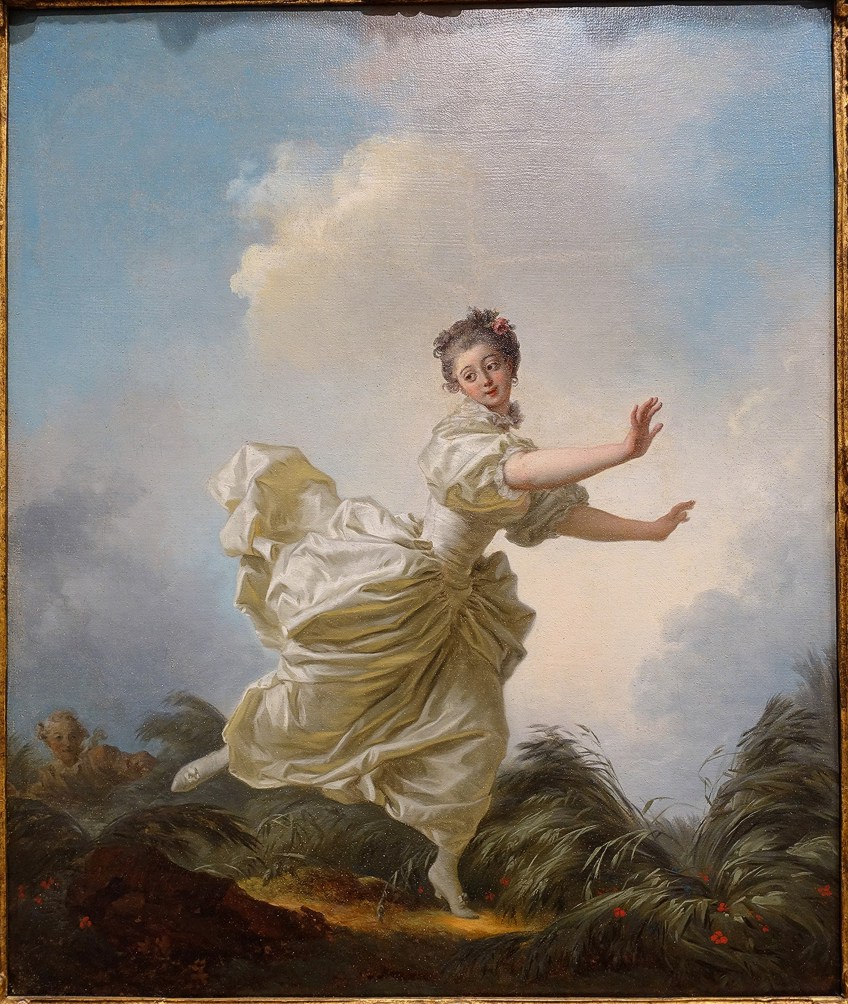 The Pre-Arranged Flying (c. 1772-1773) past Jean-Honore Fragonard; Jean-Honoré Fragonard, Public domain, via Wikimedia Commons
The Pre-Arranged Flying (c. 1772-1773) past Jean-Honore Fragonard; Jean-Honoré Fragonard, Public domain, via Wikimedia Commons
The Rococo artists of this period focused on light and pastels in their candy-colored scenes of playful courtship and leisure that captured a more than delicate and feminine essence. The Rococo movement was divers by its utilise of natural motifs, curving lines, soft colors, and themes regarding nature, playfulness, lighthearted amusement, youth, and love.
The Rococo art paintings were characterized by their intricate ornament, exuberant ornament, and asymmetrical designs. Rococo artwork exaggerated the principles of theatricality and illusion.
Our Top ten Most Famous Rococo Paintings
The Rococo motility spanned beyond the majority of the 18th century, originating in Paris and spreading across various parts of Europe. During this time, the Rococo artists that contributed to the movement left a bountiful collection of Rococo art paintings that were extravagant, elegant, and opulent; paintings that went on to inspire artists that followed and continue to exist celebrated to this 24-hour interval. Here is our selection of the summit ten most famous Rococo paintings.
The Embarkation for Cythera (1717) past Jean-Antoine Watteau
| Artist | Jean-Antoine Watteau |
| Date Painted | 1717 |
| Medium | Oil on canvas |
| Dimensions | 129 cm ten 194 cm |
| Where It Is Currently Housed | Musée du Louvre, Paris, France |
Jean-Antoine Watteau is largely regarded every bit the founder of the Rococo style painting. Incorporating influences from the Venetian Renaissance masters such as Paolo Veronese and Titian; and the Flemish giant Peter Paul Rubens, Watteau developed compositions that were dynamic in brilliantly expressive colors. Watteau presented an untamed and idyllic depiction of nature.
Besides known every bit the "Pilgrimage to the Isle of Cythera", this painting is regarded as i of Watteau'south nearly famous Rococo paintings.
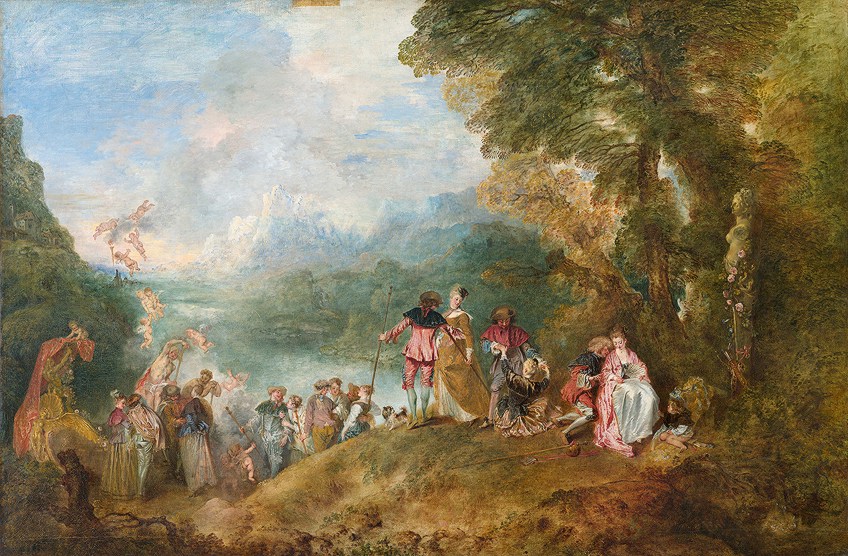 The Embarkation for Cythera (1717) past Jean-Antoine Watteau; Jean-Antoine Watteau, Public domain, via Wikimedia Commons
The Embarkation for Cythera (1717) past Jean-Antoine Watteau; Jean-Antoine Watteau, Public domain, via Wikimedia Commons
The Embarkation for Cythera merges a lush mural that is reminiscent of the Renaissance-manner with a symbolic scene where a group of couples is either set out for or returning from Cythera, a fiddling Greek island close to the site in mythology where Aphrodite, the Goddess of dearest, was born. In the foreground, at that place are three couples that each represent a separate stage of courtship. In the sky, three cupids are flying, which reflects the amorous suggestions of the island.
His painting was accepted by the Royal Academy of Painting and Sculpture which brought recognition to the newly formed genre and established the Rococo style. This introduced the fête galante, courtship painting, which involved Watteau'south signature melding of fantasy and reality in both the setting and costume in his paintings, besides as the unspecified subject area matter of his paintings.
The characteristics Watteau developed in his Rococo-mode paintings went on to inspire artists such as François Boucher and Jean-Honoré Fragonard, who later became Rococo giants.
The Entrance to the Yard Canal (c. 1730) by Canaletto
| Creative person | Canaletto |
| Engagement Painted | c. 1730 |
| Medium | Oil on canvas |
| Dimensions | 49.6 cm x 73.6 cm |
| Where Information technology Is Currently Housed | Museum of Fine Arts, Houston, United States |
In terms of Italian cityscape paintings, there is no 1 quite similar Giovanni Antonio Canal who famously went by the name Canaletto. The Entrance to the Grand Canal is regarded as his nearly famous painting, which depicts the waterway entrance that leads into Venice with gondoliers maneuvering their passengers across the canvas. Venice at the fourth dimension was a popular artistic haven. On the left of the painting, the large church depicted is the Basilica of Santa Maria della Salute.
 The Entrance to the M Culvert (c. 1730) by Canaletto; Canaletto, Public domain, via Wikimedia Commons
The Entrance to the M Culvert (c. 1730) by Canaletto; Canaletto, Public domain, via Wikimedia Commons
Canaletto'south painting featured the typical asymmetrical design of Rococo art. The asymmetrical positioning of the gondoliers indicates movement in the painting, as 3 of them extend upwards drawing your centre into the distance. The delicate work of local colors creates a gilt hue that suggests he was capturing the essence of an idyllic scene. Canaletto'due south intricate depiction of light captured the work of the sun and shadows on the beautiful Venetian architecture.
This style of landscape, the Idealized landscape, heavily inspired the Rococo style of painting.
Canaletto's The Entrance to the Yard Culvert is considered one of the most famous Rococo paintings made outside the region of French republic in the 1700s. Canaletto mastered painting from nature and expertly conveyed the atmosphere he was trying to capture. His work has maintained its acclaim and influence, in 2017 David Bickerstaff featured it in his picture show Canaletto and the Art of Venice.
Soap Bubbles (c. 1733 – 1734) by Jean-Baptiste-Siméon Chardin
| Artist | Jean-Baptiste-Siméon Chardin |
| Engagement Painted | c. 1733 – 1734 |
| Medium | Oil on canvas |
| Dimensions | 61 cm x 63.two cm |
| Where Information technology Is Currently Housed | Metropolitan Museum of Art, New York City, Usa |
In contrast to the improvident and extensive scenes often associated with Rococo artwork, Jean-Baptiste-Siméon Chardin's paintings depicted a seemingly unproblematic perspective despite him beingness a pioneer of the Rococo movement. Chardin'south well-known artworks focused on the playful disposition of children; in fact, one of his most notable pieces Soap Bubbles depicted two children playing. In this painting, he depicted a child blowing bubbles, whilst a friend watched from behind.
The colors in Soap Bubbles are quite muted, showcasing rich browns and blackness. These colors highlight the contrast of the male child'south glowing face and hands, which invite yous to focus on what the boy is doing, as the viewer you become immersed, much like the male child, in the babyhood act of bravado bubbles. Chardin's brushwork is thick and textured, mimicking the tactile textures of fabric, skin, and stone.
This painting demonstrates the feeling of childhood and the fleeting joy of idle play.
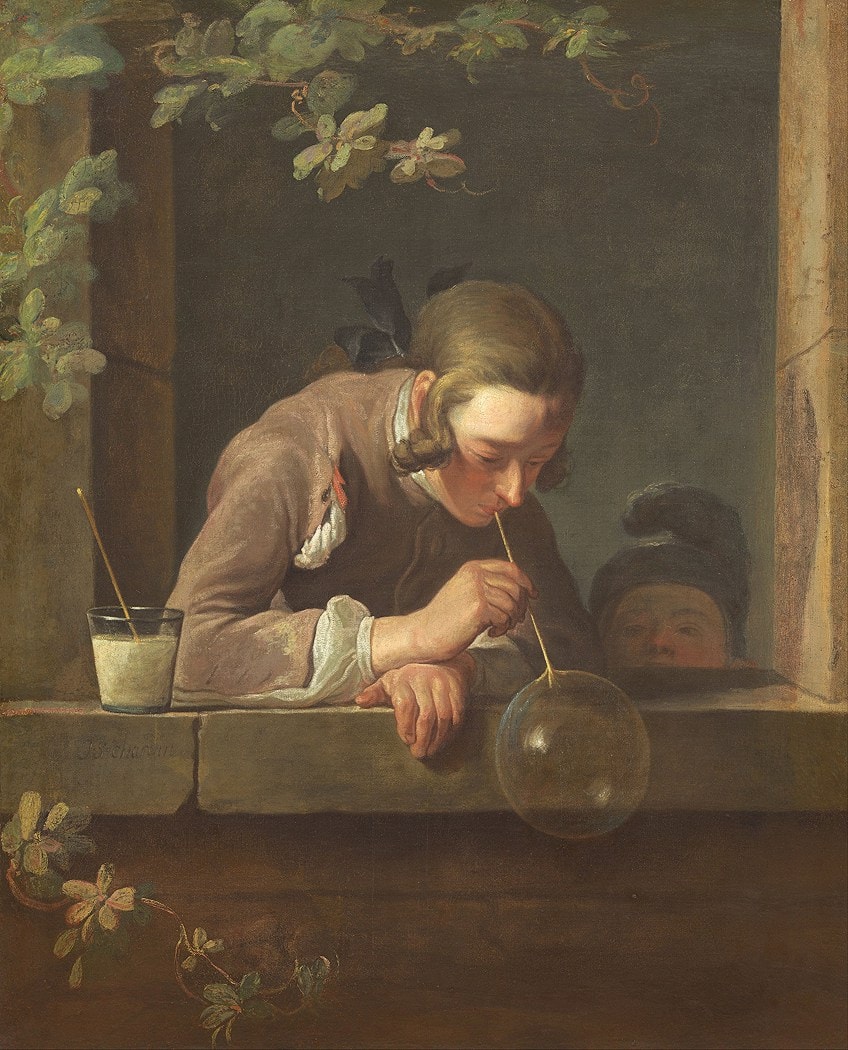 Soap Bubbles (c. 1733 – 1734) by Jean-Baptiste-Siméon Chardin; Jean-Baptiste-Siméon Chardin, Public domain, via Wikimedia Commons
Soap Bubbles (c. 1733 – 1734) by Jean-Baptiste-Siméon Chardin; Jean-Baptiste-Siméon Chardin, Public domain, via Wikimedia Commons
Following the observations of many critics and fine art historians, the painting seems to depict the innocence of childhood and the ease of amusement, rather than annihilation securely symbolic. Still, some run across the chimera as an allusive symbol of life's impermanence.
The painting served equally Chardin'south singled-out contribution to the Rococo movement, with his realistic scenes establishing a genre that depicted children at play, still lifes, and domestic scenes that all reflected the leisurely pastimes that were typical of the Rococo move.
Chardin skillfully portrayed the everyday aesthetic of the French middle-form and developed a potent following that reached iconic figures such as Vincent Van Gogh, Paul Cézanne, and Édouard Manet.
La Toilette de Vénus (1751) past François Boucher
| Artist | François Boucher |
| Date Painted | 1751 |
| Medium | Oil on canvass |
| Dimensions | 108.3 cm x 85.1 cm |
| Where It Is Currently Housed | The Metropolitan Museum of Art, New York, United States |
François Boucher's La Toilette de Vénus depicts Madame de Pompadour in the nude every bit Venus, the classical Goddess of dazzler and dearest. The painting exudes overt theatricality with Boucher's portrayal of voluptuous mankind, the asymmetrical spread of article of furniture, luxuriant fabrics, pearls, and flowers. La Toilette de Vénus was originally painted to decorate Madame de Pompadour's luxury suite of three rooms that made up her bathing apartments at her Château de Bellevue.
Both Boucher and Madame de Pompadour became synonymous with the Rococo movement.
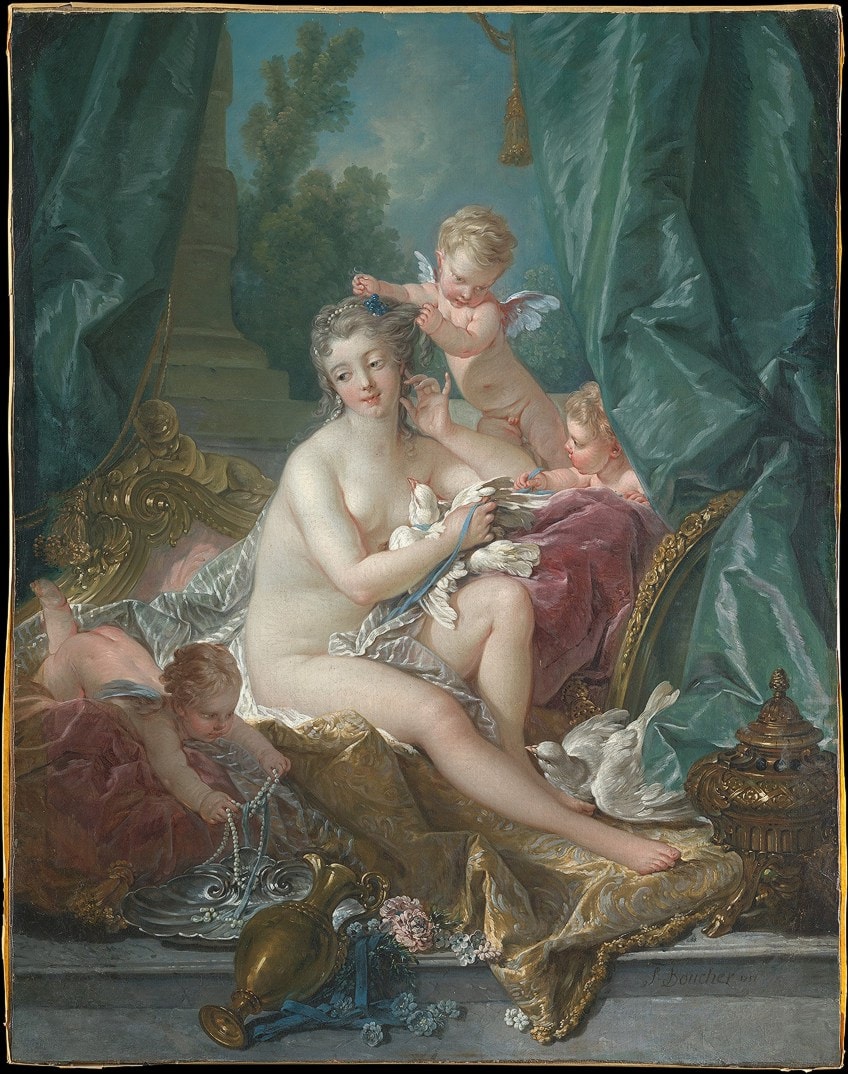 La Toilette de Vénus (1751) by François Boucher; François Boucher, CC0, via Wikimedia Commons
La Toilette de Vénus (1751) by François Boucher; François Boucher, CC0, via Wikimedia Commons
Two white doves and 3 cherubs tend to the effigy of Venus as she lounges on a seat framed in gold. The blue drapes that glisten with the light and shadow are partially open to a view of an alluring garden, which creates a captivating sense of leisure. Depicting Madame de Pompadour as Venus idealizes her and surrounding her effigy with ornate decorations enhances the overall experience of luxury.
Boucher'south sensual portrayals of the social aristocracy and notable citizens came to form part of his ain defined pictorial brand.
Madame de Pompadour became Boucher'southward most notable patron until she died in 1764. La Toilette de Vénus was one of the many portraits she had commissioned. Boucher masterfully presented the conflation of theatricality and performed identities with the existent lived identities of his subjects. Demonstrating the art of appearance that even so represented his subject'southward truthful identity. Boucher'south ability to captivatingly depict his subjects led to him condign known every bit one of the nearly famous Rococo artists in portraiture.
Allegory of the Planets and Continents (1752) by Giovanni Battista Tiepolo
| Artist | Giovanni Battista Tiepolo |
| Appointment Painted | 1752 |
| Medium | Oil on canvas |
| Dimensions | 185.iv cm 10 139.four cm |
| Where It Is Currently Housed | Metropolitan Museum of Fine art, New York, U.s.a. |
Allegory of the Planets and Continents is one of Giovanni Battista Tiepolo's most famous paintings and contributions to Italian Rococo, which was based on French Rococo style and an airier expression of the preceding Bizarre style. Apologue of the Planets and Continents portrays an exuberant arrangement of heavenly figures that together represent the various planets and Globe's continents.
The painting was created to be hung on the ceiling of the staircase at the Würzburg Residence in Germany for Carl Phillip von Grieffenklau, the prince-bishop.
 Allegory of the Planets and Continents (1752) past Giovanni Battista Tiepolo; Giovanni Battista Tiepolo, Public domain, via Wikimedia Commons
Allegory of the Planets and Continents (1752) past Giovanni Battista Tiepolo; Giovanni Battista Tiepolo, Public domain, via Wikimedia Commons
Tiepolo's spectacularly festive portrayal of the dominicus's motility through the heaven demonstrates a splendor of colour, calorie-free, and swirling patterns. To the left of the center, you tin see Apollo, the Greek God of the sun, who is illuminated from behind by a shining orb as he calls to the dominicus horses that stand up to his correct. The remaining Gods symbolize the planets swirling around Apollo, the sun. The edge features many figures pointing towards the painting's middle as if to indicate that inward lies divinity. The figures represent people of Africa, America, Asia, and Europe.
The big fresco was composed so that individual sections of the painting could exist viewed separately at specific stopping places. Tiepolo fabricated information technology seem equally if the perspective would adjust to the viewer's position.
Tiepolo'southward genius could be witnessed in the system of his pastels, he would create tension in the scene that would highlight the dramatic poses and narrative movement of his figures to develop a lively outcome. With his imagination, he created a theatrical linguistic communication to convey ancient narratives and sacred legends. It was Tiepolo's genius that inspired artists such as Francisco Goya.
Portrait of Madame de Pompadour (1756) by François Boucher
| Artist | François Boucher |
| Date Painted | 1756 |
| Medium | Oil on canvass |
| Dimensions | 212 cm x 164 cm |
| Where It Is Currently Housed | Alte Pinakothek, Munich, Deutschland |
François Boucher's exquisite Portrait of Madame de Pompadour depicted the mistress of King Louis XV. Madame de Pompadour embodied the essence of the Rococo way, and she became associated with the movement as she had authorization over all things stylish. This was some other portrait past Boucher that she had commissioned. Boucher's portrait aptly portrayed her as lavish, corrupt, and fashionably elegant. Boucher's total-sized portrait depicted Madame de Pompadour reclining in her luxuriant green silk gown, patterned with pinkish roses.
Extravagant tones of aureate glaze the painting, with the golden brocades framing the room and an intricate golden cartel clock above the fireplace providing sumptuous detail to the painting.
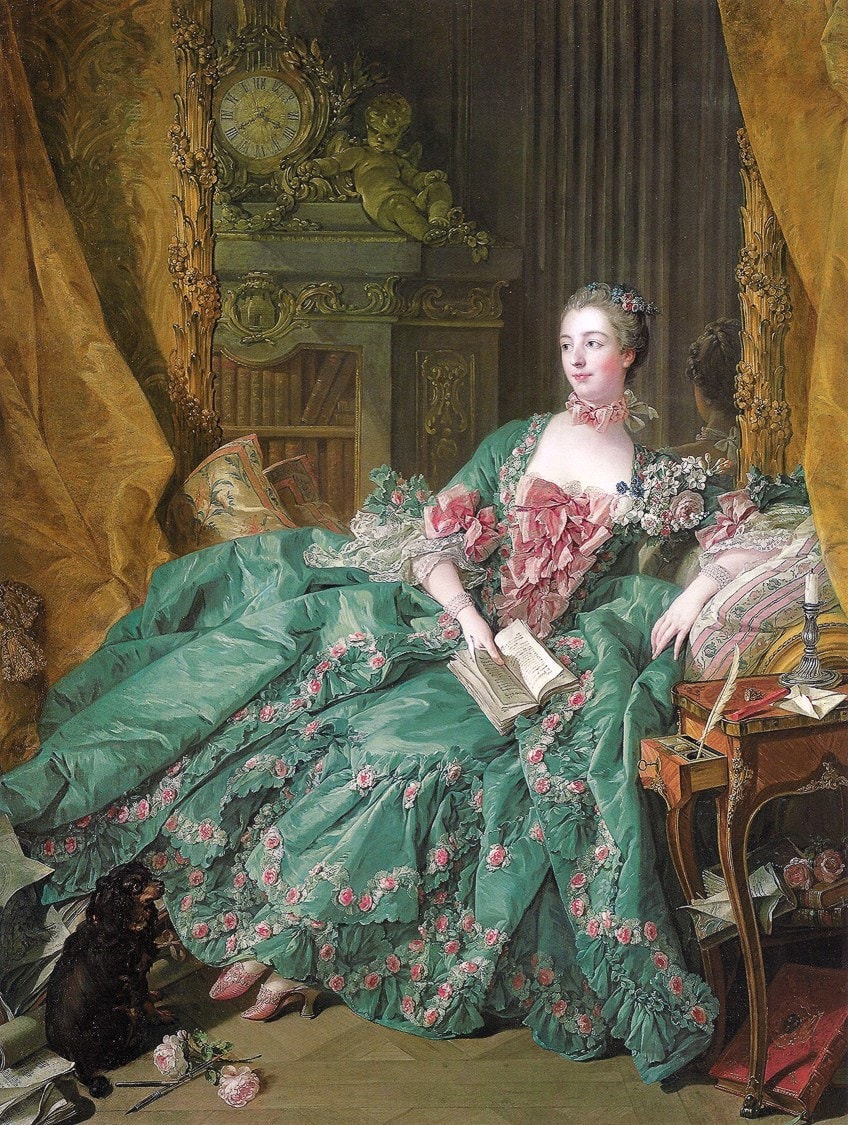 Portrait of Madame de Pompadour (1756) by François Boucher; François Boucher, Public domain, via Wikimedia Commons
Portrait of Madame de Pompadour (1756) by François Boucher; François Boucher, Public domain, via Wikimedia Commons
The painting is rich in symbolism with details such every bit a full bookcase with several books littered beyond the floor, and the lyre-shaped clock adorned with laurels. Symbolizing her love of poetry, music, and literature. The painting conveys pleasurable leisure and confidence, yet it is still able to demonstrate the weight of her intellectual influence with a quill and open up book in hand.
Madame de Pompadour'southward pose, with a turned gaze to her left, represented deep philosophical thought. Boucher'south work on Portrait of Madame de Pompadour has served as a somewhat social iconography, with each factor existence called advisedly and unified stylistically to portray an ideal paradigm. Boucher's portrayals of Madame de Pompadour demonstrated the quintessential Rococo style painting.
Madame de Pompadour propelled the Rococo movement forward due to her influence.
The Bathers (1765) by Jean-Honoré Fragonard
| Artist | Jean-Honoré Fragonard |
| Date Painted | 1765 |
| Medium | Oil on canvas |
| Dimensions | eighty cm x 64 cm |
| Where It Is Currently Housed | Musée du Louvre, Paris, France |
Jean-Honoré Fragonard developed a distinct style during the French Rococo period. He often used colors that were more vibrant in comparison to his counterparts, not only that but his paintings, in general, differed quite a flake from the Rococo artwork that came out of the early on 18th century. One of his famous Rococo paintings is titled The Bathers, which depicts eight women lightheartedly bathing in the sun.
The trees surrounding the women frame their bodies as they are all arranged in various poses, each expressing unique personalities and characteristics.
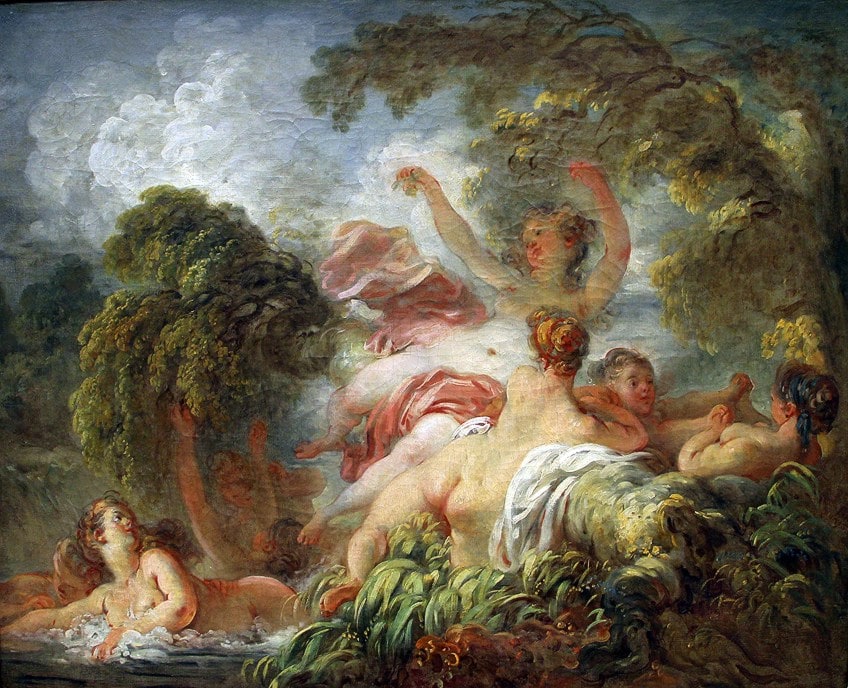 The Bathers (1765) by Jean-Honoré Fragonard; Jean-Honoré Fragonard, Public domain, via Wikimedia Commons
The Bathers (1765) by Jean-Honoré Fragonard; Jean-Honoré Fragonard, Public domain, via Wikimedia Commons
The bathing scene was pop during the Rococo menstruum. It was often used as a ways to show off the Rococo artists' skills equally they had to paint the nude figures in a variety of positions from diverse angles, and of course, the provocative subject affair edged towards the titillating. In The Bathers, in that location was a lightness nigh the palette and the theme, equally the lighter tones of colors used were suited to expressing the gentleness and innocence of the women.
Fragonard's brushwork was palpable and loose which provided a sense of fluidity that contributed to the liveliness of the Rococo artwork.
The Bathers was one of the final few of Fragonard'due south Rococo art paintings to be publicly displayed and exhibited, in 1767 he began to solely pigment for individual clients. Fragonard was one of the Rococo artists at the epicenter of the movement, he contributed well over 500 spectacular paintings to the movement documenting the decadence of the times and illustrating carefree amusement and images of splendor.
The Swing (1767) past Jean-Honoré Fragonard
| Artist | Jean-Honoré Fragonard |
| Date Painted | 1767 |
| Medium | Oil on canvas |
| Dimensions | 81 cm 10 64.2 cm |
| Where Information technology Is Currently Housed | Wallace Collection, London, U.k. |
The Swing is another instance of Jean-Honoré Fragonard's masterful work. The Rococo artwork depicts a graceful young woman who is swinging playfully from the branch of a tree equally a fellow looks to her from below and another man behind her stands in the shadows pulling her swing by rope. The human in front of her is positioned in such a way that he would have a view underneath her dress, which exemplified the Hedonism of the Rococo era, which was often present in Fragonard's artwork.
The Swing is the quintessential Rococo style painting, with Fragonard's signature deft brushwork, soft colors and lighting, and frivolously light-hearted themes. The immature woman's frothy pink dress billows as she is poised in mid-air, exposing her legs to the man blushing beneath. Tantalizingly, she kicks off her she toward the statue of cupid, the God of honey and desire. At the time, the shoeless foot of a woman was symbolic of nudity.
In a presumed ploy to be ironic, Fragonard clad the woman in a bergère hat, shepherdess hat, which symbolized purity and virtue.
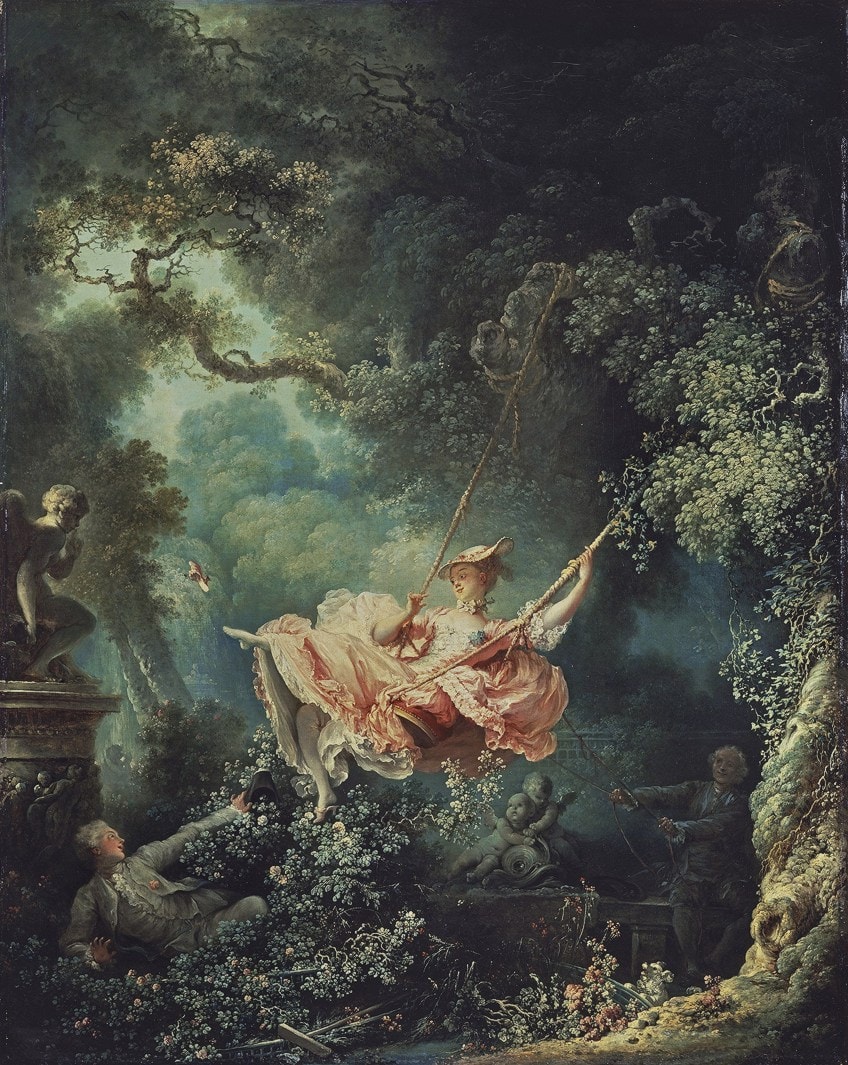 The Happy Accidents of the Swing (1767) by Jean-Honoré Fragonard;Jean-Honoré Fragonard, Public domain, via Wikimedia Commons
The Happy Accidents of the Swing (1767) by Jean-Honoré Fragonard;Jean-Honoré Fragonard, Public domain, via Wikimedia Commons
The Swing is recognized as one of the most famous artworks from the Rococo era. The asymmetrical composition, the lush scenery, playfulness, nonchalance, and layered eroticism exemplified the characteristics of the Rococo manner. The Swing has cemented its identify as a cultural and artistic icon.
There have been several nods made to this e'er-inspiring slice, with notable mentions in popular culture such as the Disney moving-picture show Frozen, where information technology is seen sitting in an art gallery, or when it was referenced by the contemporary artists' Kent Monkman and Yinka Shonibare in their work, or as office of Larry Moss' 3D art installation at the Phelps Art Center.
The Blueish Boy (c. 1770) by Thomas Gainsborough
| Artist | Thomas Gainsborough |
| Date Painted | c. 1770 |
| Medium | Oil on canvas |
| Dimensions | 177.8 cm 10 112.one cm |
| Where It Is Currently Housed | Henry E. Huntington Art Gallery, San Marino, California, United states |
The Blue Boy is considered one of Thomas Gainsborough'due south virtually famous Rococo paintings. Information technology depicts a portrait of a male child in a blue compatible, every bit a costume study. The rosy-cheeked young boy is elegantly dressed in a detailed costume confronting a turbulent landscape Gainsborough was influenced by the French Rococo fashion through his learnings at the St. Martin'southward Lane University which inspired his exploration of the dynamics betwixt people and their environments. With this involvement, he depicted many portraits of extravagantly dressed figures in lush outdoor scenes.
The painting was influenced by Anthony van Dyck and demonstrated Gainsborough'south get-go endeavor at creating a van Dyck-style costume with the boy's azure outfit.
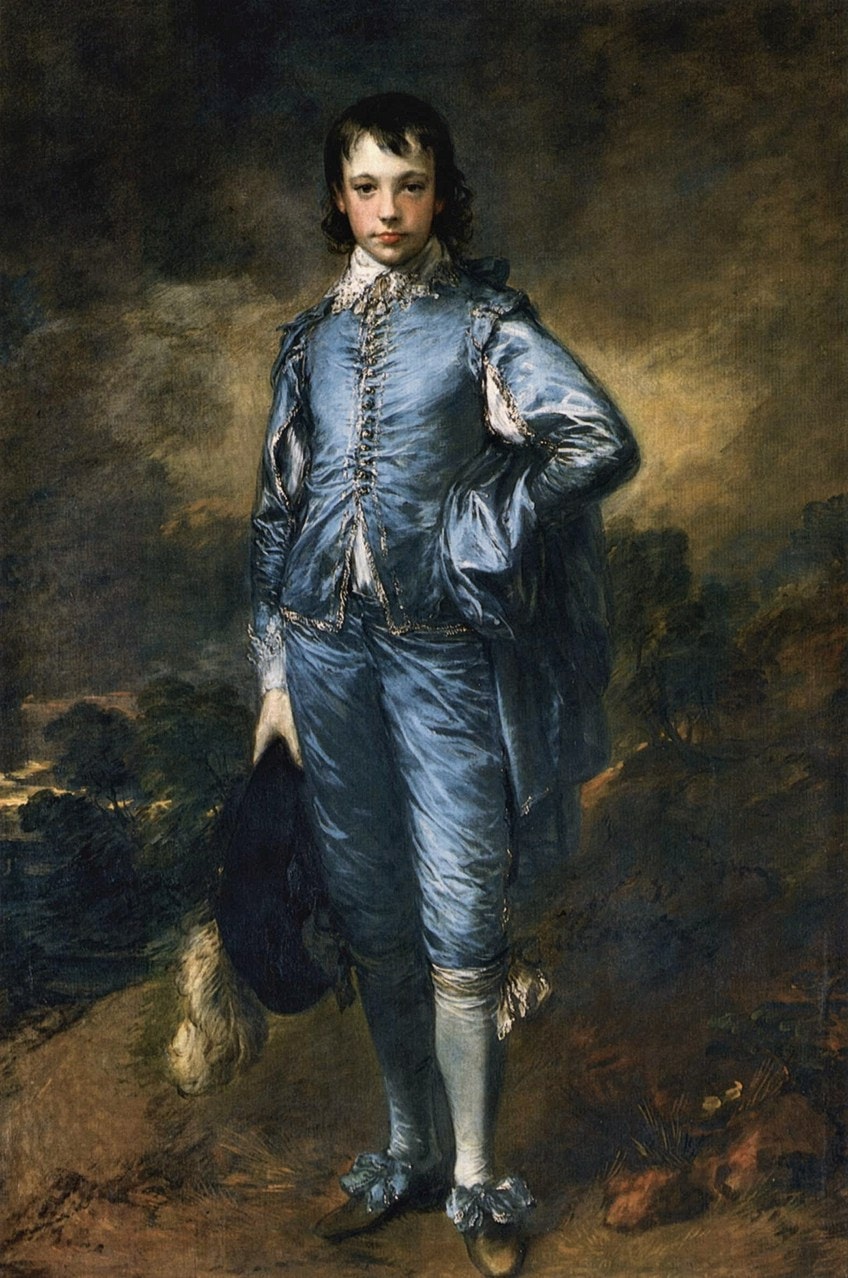 Jonathan Buttall (The Blueish Male child) (c. 1770) by Thomas Gainsborough;Thomas Gainsborough, Public domain, via Wikimedia Commons
Jonathan Buttall (The Blueish Male child) (c. 1770) by Thomas Gainsborough;Thomas Gainsborough, Public domain, via Wikimedia Commons
Gainsborough creates a contrast between the rustic background and the delicate effigy. The life-sized portrait illustrates exceptional technical skill and reflects his capable undertaking of the Rococo style of merging fantasy and reality. The fine and slashed layered brushwork had intricate tints of turquoise, lapis lazuli, cobalt, indigo, and slate– making the blue electric against the stormy landscape scene.
The Blue Boy was Gainsborough's masterpiece. Information technology challenged the traditional assumptions around aesthetics since blueish was traditionally considered as only a groundwork element, yet Gainsborough featured it every bit his primary colour.
The painting reflected the traditions of the Rococo style, merely information technology also incorporated innovative features of realism such every bit the tightly laced buttons.
The painting was an firsthand success. From its debut to the nowadays day, the painting remains an inspirational piece of work, having inspired everything from songs such every bit Blue Male child Blues by Cole Porter to one of the costumes of the main character Django in Quentin Tarantino's film Django Unchained.
Self-Portrait with Straw Hat (1782) by Élisabeth Louise Vigée Le Brun
| Artist | Élisabeth Louise Vigée Le Brun |
| Engagement Painted | 1782 |
| Medium | Oil on sheet |
| Dimensions | 97.8 cm ten lxx.5 cm |
| Where It Is Currently Housed | National Gallery, London, Great britain |
Élisabeth Louise Vigée Le Brun was one of the prolific painters of her fourth dimension. Although some of Le Brun's paintings incorporated elements of the Neoclassical mode, her portraits were largely considered Rococo-manner paintings. She was considered one of the more notable Rococo artists for a number of reasons; apart from her immense skills, she was Marie Antoinette'due south pb portrait artist. In Self-Portrait with Straw Hat, she painted a self-portrait where she managed to capture both casual and aristocratic elegance when depicting her own artistic expertise.
This painting brilliantly shows off elements of the French Rococo style; the loose brushstrokes, which are peculiarly evident when you lot look at her hair; the pastel colors; and her youthful whimsical facial expression.
 Self-Portrait with Straw Hat (after 1782) by Élisabeth Louise Vigée Le Brun; Elisabeth Louise Vigée-LeBrun, Public domain, via Wikimedia Eatables
Self-Portrait with Straw Hat (after 1782) by Élisabeth Louise Vigée Le Brun; Elisabeth Louise Vigée-LeBrun, Public domain, via Wikimedia Eatables
Her face is shadowed softly which reveals her confident gaze directed at the viewer. Le Brun has accomplished a deliberate nonchalance in her painting, as she portrayed herself as a serious creative person. Her painting was influenced past Le Hat de Paille by Peter Paul Rubens.
During this fourth dimension, women artists were mainly limited to painting portraits. Le Brun produced more than than 220 landscape paintings and 660 portraits during her time, with some of her paintings exhibited in world-renowned museums across the globe. She was i of the nigh renowned of the women Rococo artists. Le Brun battled many barriers past pursuing a career dominated by men, however she prevailed and was 1 of the 4 women that were officially accepted in the Royal Academy of Fine Arts, helping her get one of the first women to gain international acclaim.
The famous Rococo paintings that were discussed in this article continue to hold significance to this day. While the list shows our option of the top 10 well-nigh famous Rococo paintings, there are countless paintings from this movement that are worth looking at. If you lot enjoyed this article, nosotros think you lot might enjoy our other work and we encourage you to explore more of our website!
Have a look at our Rococo painting webstory here!
Frequently Asked Questions
What Is the Rococo Menstruation?
The Rococo period was an opulent visual movement that was established in c. 1720 Paris and spread throughout France and other parts of Europe including Italian republic, Germany, Russia, and Republic of austria. The Rococo artists of this menstruum focused on attention to detail, with its candy-colored scenes of playful courting and extreme leisure. The movement spanned the majority of the 18th century. The word Rococo is derived from the French give-and-take rocaille, meaning pebble or rock, and it refers to the stones and shells that were used to decorate the interiors of grottoes since the Renaissance. The term "rocaille" was used to describe the decorative and ornamental style that was featured in Rococo paintings.
What Influenced Rococo Art?
The Rococo movement began equally a reaction to the more formal grandeur and heaviness of the Baroque manner that preceded it, past contrasting it with delicate lightness and whimsy. Male monarch Louis Fifteen was considered a "perpetual adolescent", which is why the playful nature of the French Rococo was and then suitable for his reign. The Rococo motility became synonymous with the compelling Madame de Pompadour, the new King XV'due south mistress. Madame de Pompadour embodied the essence of the Rococo style, and she became associated with the move as she had dominance over all things stylish and she was a notable patron of the move.
What Are the Defining Features of Rococo Art?
The Rococo move was defined past its use of natural motifs, curving lines, soft and pastel colors, and themes regarding nature, playfulness, lighthearted amusement, youth, and honey. The Rococo art paintings were characterized past their intricate ornamentation, exuberant decoration, and asymmetrical designs. Rococo artwork exaggerated the principles of theatricality and illusion.
Source: https://artincontext.org/famous-rococo-paintings/
0 Response to "What Art Movement Represented a Rich Leisurely Lifestyle in France"
Postar um comentário